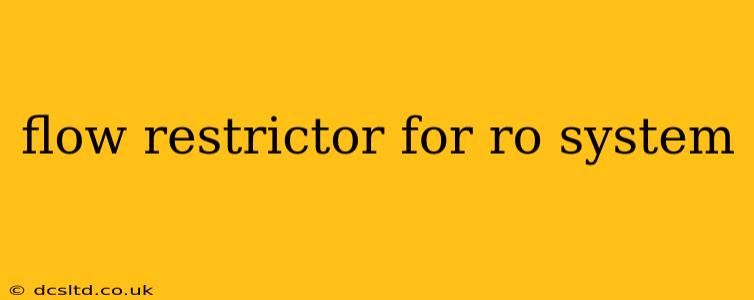Reverse osmosis (RO) systems are popular for providing clean, purified water, but sometimes, they need a little help to operate at peak efficiency. One common solution is a flow restrictor. This guide will explore everything you need to know about flow restrictors for RO systems, answering common questions and helping you understand their importance.
What is a Flow Restrictor in an RO System?
A flow restrictor in an RO system is a small device that controls the rate of water flow through the membrane. It's crucial because RO membranes are sensitive to pressure. Too much pressure can damage the membrane, leading to premature failure and reduced lifespan. Conversely, too little pressure means the system won't produce enough purified water. The flow restrictor ensures the optimal water flow, maximizing efficiency and membrane longevity. Think of it as a delicate balance keeper for your system's performance.
Why is a Flow Restrictor Necessary for My RO System?
The primary function of a flow restrictor is to protect the RO membrane. High pressure can force water through the membrane too quickly, potentially causing damage. A properly installed flow restrictor maintains the correct pressure, ensuring the membrane operates within its optimal parameters. This extends the lifespan of your membrane, saving you money on replacements in the long run. Furthermore, the restrictor ensures consistent purified water production. Without it, you might experience inconsistent water output, fluctuations in pressure, and potential damage to other components of the system.
What Happens if My RO System Doesn't Have a Flow Restrictor?
Operating an RO system without a flow restrictor is risky. The most significant consequence is potential membrane damage. Without controlled water flow, the high pressure can force contaminants through the membrane, reducing its effectiveness and shortening its life. You'll also likely experience inconsistent water production, potentially leading to inefficient water usage and higher utility bills. In severe cases, the high pressure could damage other components of the system, necessitating costly repairs.
How Does a Flow Restrictor Work in an RO System?
A flow restrictor operates by simply reducing the flow rate of water. This is usually achieved through a small orifice or a capillary tube. The restrictor is typically installed in the line between the high-pressure pump and the RO membrane. By limiting the amount of water that reaches the membrane, it regulates the pressure to an ideal level for optimal performance and membrane protection. It acts as a pressure regulator, safeguarding the system's most vulnerable component.
What are the Different Types of Flow Restrictors for RO Systems?
While many RO systems utilize a simple built-in restrictor, several types exist, each offering slightly different levels of control and precision. Some systems utilize a fixed orifice restrictor, providing a consistent flow rate. Others may use adjustable restrictors, allowing for fine-tuning of the water flow based on specific needs or water pressure variations. The specific type of restrictor used will depend on the manufacturer and the RO system's design.
How Often Should I Replace My RO System's Flow Restrictor?
Generally, flow restrictors are durable and don't require frequent replacement. Unlike the RO membrane, which needs periodic replacement, the restrictor's lifespan is usually much longer. However, if you notice a significant decrease in water production, inconsistent flow, or an increase in water pressure, it might indicate a problem with the restrictor and warrant inspection or replacement. Always consult your RO system's manual for specific maintenance recommendations.
Can I Adjust the Flow Restrictor Myself?
Adjusting the flow restrictor is generally not recommended unless you are experienced with RO systems. Incorrect adjustment can lead to damage to the membrane or other components. Always consult the manufacturer's instructions, or if unsure, contact a qualified professional for assistance. Improper adjustment can negate the protective benefits of the restrictor, potentially leading to costly repairs or premature membrane failure.
In conclusion, the flow restrictor is an often-overlooked but critical component of any RO system. By understanding its function and importance, you can ensure your system operates efficiently and effectively, prolonging the life of your RO membrane and maintaining a steady supply of clean, purified water.
